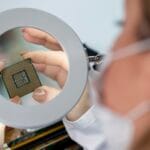FPGA Insights has engaged in an exclusive interview with Humayun Siraj, Trainee FPGA Design Engineer at Digitek Engineering
Q1) Can you provide an overview of your experience with FPGA design projects, mentioning a few that you’ve worked on, starting with a brief introduction?
Our organization specializes in providing custom FPGA design services and hardware design solutions. We cater to a diverse range of requirements, from developing small communication modules to high-speed, high-performance board and FPGA designs.
Furthermore, we provide a robust set of industry-leading Ethernet FPGA IP Cores, including DMA, FEC, and UDP/IP Offload Engines, among others. These IP cores enhance the functionality and performance of FPGA-based systems, making us a one-stop solution for advanced FPGA and hardware design needs.
Q2) Can you explain the benefits of using FPGAs over other types of processors?
The key features of an FPGA over other processors are customization; it offers custom hardware optimization for performance optimization; it also offers low latency, i.e., minimal delay in processing, which suits batch-time applications best.
One of the key features of fpga is parallelism. fpga can perform multiple parallel processing operations, which result in increased output. If we have shared resources, it is better to execute data simultaneously, resulting in low latency and maximum throughput.
FGPA provides quick prototyping of hardware. Flexibility, as FPGA offers us, to modify the hardware as per the requirement, as we intended to modify the implemented algorithm.
Q3) What are the most significant trends observed in the FPGA industry over the past year? How will these trends shape the industry’s future?
The recent trends observed in the FPGA industry include the customization of hardware features that tailor the modification of a digital system’s hardware.
The Asics industry widely uses FPGAs for hardware prototyping and testing of digital designs. Fpga offers rapid and cheap hardware prototyping that helps reconfiguration and upgrade.
Nowadays, FPGAs are widely used for the implementation of high-speed communication, servers in large-scale data centers, and even ML and DL applications.
FPGA Nowadays, small-scale FPGAs are attached to processors and controllers as they can perform parallel processing, and the microprocessor helps in multiple processing unit
Q4) How do you see FPGA development evolving to meet the demands of modern applications and complex workloads?
FPGA development increased prominently because of the features offered by FPGA. Various industrial sectors adopt a FPG-based solution for their products when they are in the development stage.
Today, for high-speed, highly computational, large-scale data processing applications, FPGA is a well-suited solution.
Q5) What are the key drivers behind the increasing adoption of FPGAs in various applications and industries?
The key features offered by FPGA, including parallel processing, low latency, inexpensive prototyping, reconfigurability, and programmability, are resolving many issues of high-speed, high-scale processing and computation, resulting in the frequent adoption of FPGA.
Small and medium-scale industries are adopting FPGA due to the features mentioned above, as tangibility in FPGA helps them reconfigure it based on their application. while digitization requires more and more processing, so FPGs are an efficient choice for it.
Q6) What are the sectors that stand to benefit the most from FPGA integration, and why?
The application of FPGA can revolutionize various industrial, scientific and technological domains. For instance, big data centers require a very large scale of data processing, and FPGA features of concurrent processing large-scale data can be processed efficiently.
Networking, as FPGA offers low latency reconfiguration of hardware high-speed communication applications like NIC routers, offload engines, etc., are the best option. Financial services, as FPGA provides high-speed processing, consequently data analysis algorithms can be performed at a very high rate.
The automotive industry is also adopting FPGA in driving assistant vehicles because of the above-mentioned features.
Q7) The role of FPGAs in accelerating AI applications and the advancements expected in the near future
FPGA can significantly impart a key role as an AI accelerator, as FPGA features of parallel processing, high-speed computation, low latency, and hardware reconfigurable features are well suited to enhance AI learning and processing requirements.
We can even modify the hardware based on AI tasks. Multi-tasking for AI applications, as FGPA offers concurrent processing and can handle multiple tasks simultaneously, is a key feature; therefore, it can effectively contribute to accelerating AI advancement.
Q8) Ensuring the security and integrity of FPGA designs, especially in sensitive applications like finance and defense
The next generation of FPGAs offers built-in security features. While there are some IPs available to make FPGA systems secure, we cannot say about a fully secure FPGA system because there might be loopholes and reverse engineering techniques that can significantly threaten FPGA security.
We can utilize features like encryption, IP protection (IP that secures your system from reverse engineering), secure communication for data transmission, authentication and authorization mechanisms, and a secure boot that verifies the integrity of the FPGA configuration.
Q9) Advice for students and professionals interested in pursuing a career in FPGA development to stay updated with the latest trends and technologies
Build a strong theoretical foundation in digital design to efficiently implement FPGA designs. Start with small pilot projects to stay motivated and gain practical experience.
Understand pipelining and parallel design techniques to utilize the FPGA’s parallel processing capabilities. Learn communication protocols and interfaces like Avalon and AXI for interfacing with external devices. Practice designing basic processing units as a foundational skill.
Utilize Intel’s training sessions and video lectures on FPGA development for valuable insights and knowledge enhancement












